高考英语语法一点通课件——Lesson 1 句子成分、句子结构与句子种类
文档属性
| 名称 | 高考英语语法一点通课件——Lesson 1 句子成分、句子结构与句子种类 | 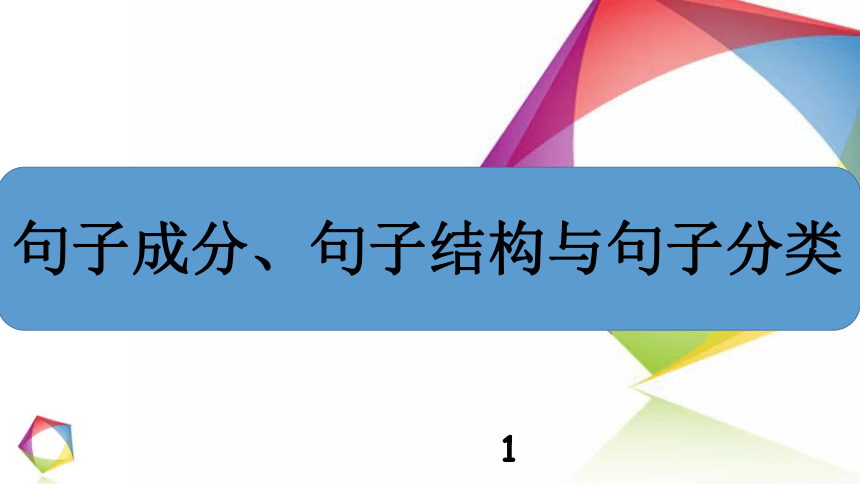 | |
| 格式 | pptx | ||
| 文件大小 | 4.8MB | ||
| 资源类型 | 试卷 | ||
| 版本资源 | 通用版 | ||
| 科目 | 英语 | ||
| 更新时间 | 2022-04-11 14:52:22 | ||
图片预览



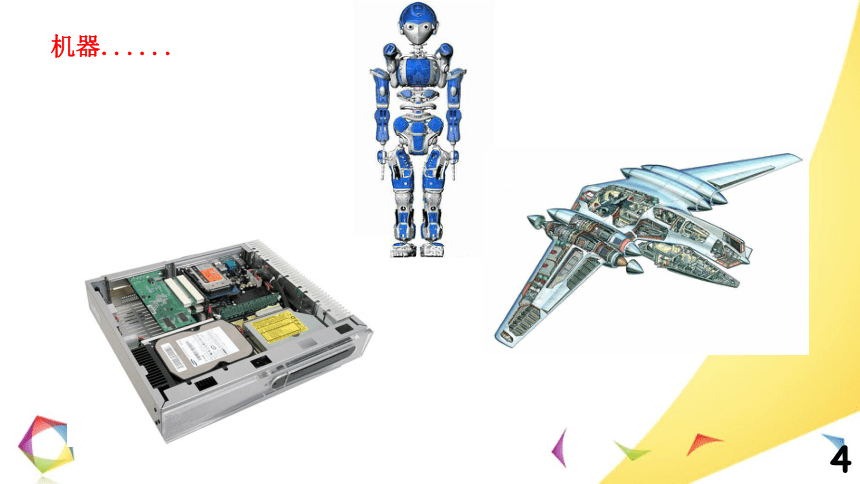

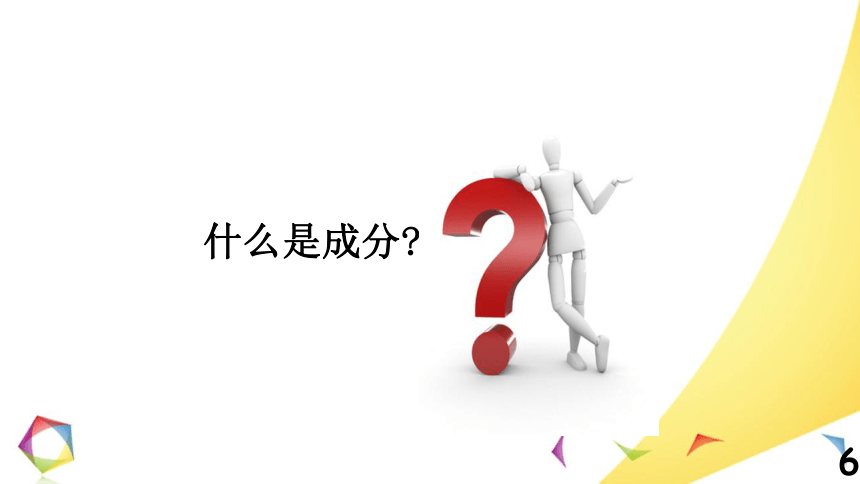


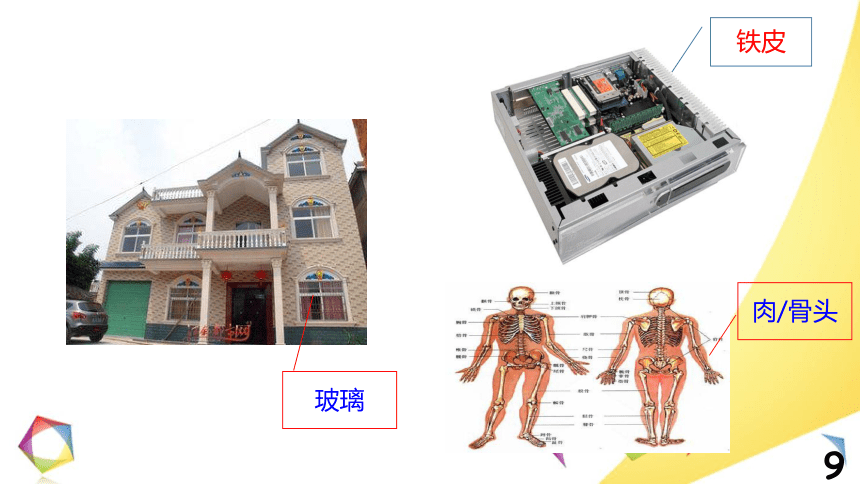
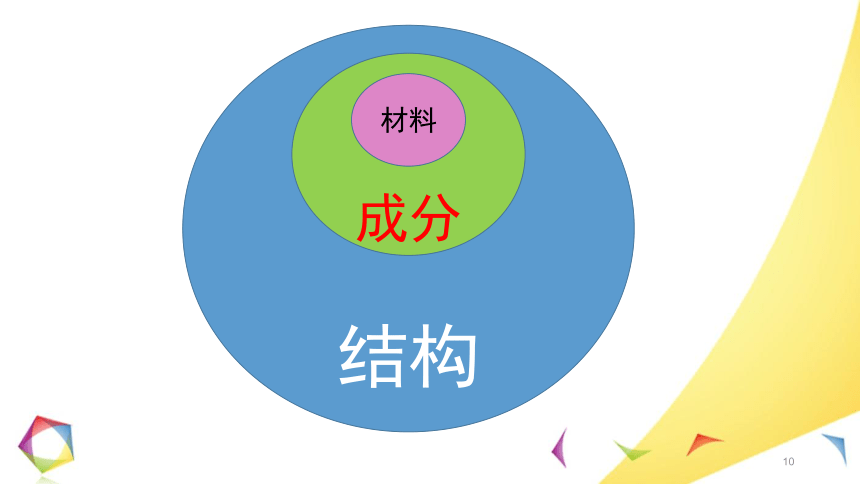

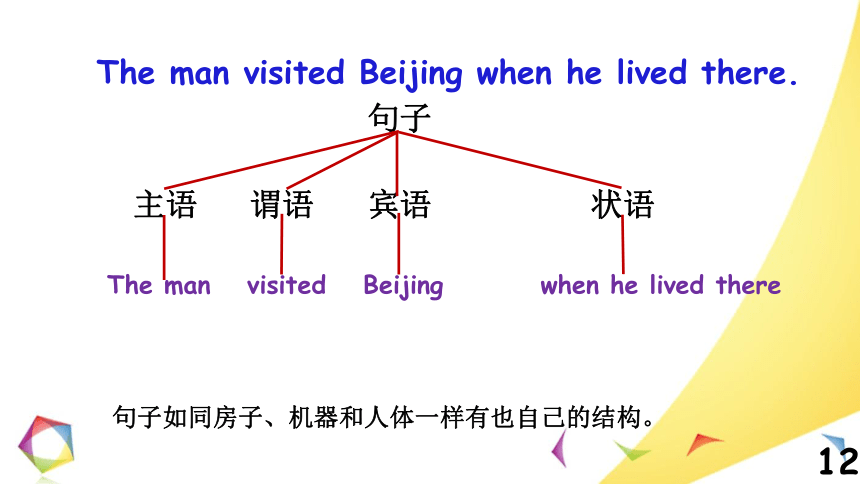
文档简介
(共79张PPT)
句子成分、句子结构与句子分类结构是什么?生活中的结构......房子......机器......人体......什么是成分 什么是材料 铁皮玻璃肉/骨头结构成分材料句子有没有结构?句子如同房子、机器和人体一样有也自己的结构。The man visited Beijingwhen he lived there.句子主语宾语谓语状语The manvisitedBeijingwhen he lived there句子的组成部分是什么?句子组成部分:句子成分句子主语宾语谓语状语The manvisitedBeijingwhen he lived there句子成分由什么充当?句子主语宾语谓语状语The manvisitedBeijingwhen he lived there句子成分由词、短语和句子组成主语:the man(名词短语)谓语:visited (动词)宾语:Beijing(名词)状语:when he lived there(从句)桌子木头桌面电影演员角色句子词/短语/句子成分man (名词)、visit (动词)......除了名词和动词,英语中还有哪些词?数词冠词名词感叹词动词代词副词介词形容词连词十大词类冠词aanthe冠词:冠词是一种虚词,本身不能独立使用,只能放在名词前帮助说明名词所指的人或事物。名词studentboydeskChinablackboardfoodcoatroom名词:表示人或事物的名称代词Iourallboththemeveryonenonesomething代词:用于代替名词的词数词onefirstninetwentiethhundredeighty-secondmillionfifty-one数词:表示数量或顺序的词形容词goodcheapcleanbigbeautifultallheavyrich形容词:描述人或事物的词,表示人或事物的特征。副词wellquicklynoweverywherecarefullytooloudlyvery副词:副词是一种用来修饰动词、形容词、副词和全句的词,说明时间,地点,程度,方式等概念。介词innearfromintobehindtobyunder介词:表示名词、代词等与句中其他词的关系, 可表示时间、地点、位置和方式等。介词在句中不能单独作句子成分,后面必须加上名词,构成介词短语,才可以充当句子成分。动词runstudysleeplistenlikeheargivego动词:表示各类动作的词连词andwhenorifbutbecausesowhile连词:连词是用来连接词与词、词组与词组或句子与句子、表示某种逻辑关系的虚词。感叹句ohyeahouchhihello感叹词:表示说话时喜悦、惊讶等感情的词句子成分英语句子成分有哪些?八大句子成分主语补语状语定语宾语谓语同位语表语主语主语是一个句子的主体陈述对象,一般位于句首和谓语动词之前。The workersare building the bridge.Cleaning the classroomafter school is our duty.谓语谓语是用来陈述主语做了什么事或处于某种状态,一般位于主语之后。He usuallywatchesTV after dinner.The babyturns aroundin the bed,opensher eyesandcries.1、简单谓语:由单个的动词或动词短语充当。
He visits his grandparents every Sunday.
The boy played football yesterday.
Lucy gets up very late in the morning.
She looks after her little sister when her parents are out.
2、复合谓语:由“be动词、助动词或者情态动词+动词”充当。
He can jump over the fence.
Lily is watching TV.
I didn't attend the party last night.
We should care about the old people.
谓语的分类
3、并列谓语:由两个以上动词并列作谓语,中间用and连结。
The teacher came in the classroom and sat down.
Tom watched the film and laughed happily.
He went back, finished his homework and went to sleep.
She gets up, puts on clothes, washes her face and has breakfast.
谓语动词如何并列?
两个谓语动词并列:
谓语 1 and 谓语 2
三个以上谓语动词并列:
谓语 1,谓语 2 and 谓语 3
谓语 1,谓语 2,谓语 3 and 谓语 4
一个句子可以有几个谓语动词?
一个句子必须有谓语,且有且只有一个谓语动词。
He likes plays football.
He likes playing football.
He wanted have a bike.
He wanted to have a bike.
She sat on the sofa, watched TV.
She sat on the sofa and watched TV.
The boy comes from the USA, he likes Chinese food.
The boy comes from the USA and he likes Chinese food.
宾语宾语是动作的对象或承受者,一般位于及物动词和介词之后。I likecoffee.I hatehima lot.实义动词分类一及物动词vt不及物动词vi后面必须跟宾语,意义才完整的实义动词,叫做及物动词。visit, see, give, tell, wash, watch, buy, hear, thank, spend, keepgo, die, fall, run, fly, jump, speak, listen, happen本身意义完整,后面不用跟宾语的实义动词,叫做不及物动词。表语表语用于说明主语的性质、特征和身份等,放在系动词后面。Finally he becomesa policeman.The workers lookedtiredafter work.系动词状态类系动词beTheyarestudents.Heisill.感官类系动词look, sound, smell, taste, feelThis kind of paperfeelssoft.This flowersmellssweet.The applestastegood.变化类系动词become, get, turn, go,comeThe day isbecomingshorter and shorter.You aregettingfatter.The leavesturnyellow in autumn.系动词+名词/形容词保持类系动词keep, stay, remainHe alwayskeptsilent at class.The windowstayedopen all the night.宾语补足语宾语补足语放在宾语后面,对宾语进行进一步的补充说明,讲述宾语的状态或者特征。All the students consider himan excellent teacher.I find the bookuseful.同位语句子中指代同一事物的两个词、短语或句子,称同位关系。同位语用以对前面的名词进行进一步的补充和说明。John,an American boy, is seven years old.Webothare students.定语定语是用来修饰、限定、说明名词或代词的品质与特征的。Therichpeople are not always happy ones.The studentsin my classare all smart.状语修饰动词、形容词、副词等的句子成分叫状语。状语说明地点、时间、原因、目的、结果、条件、程度、方式等。He studieshard.The lady isseriouslyill.常见词类的作用冠词主语谓语宾语定语状语同位语表语补语anapple名词主语谓语宾语定语状语同位语表语补语Applestaste good.I likeapples.This is anappletree.I will go to Beijingtomorrow.I find hera kind girl.He isa writer.The man,a great inventor, died.代词主语谓语宾语定语状语同位语表语补语Ilike English.We all likehim.Mybook is on the table.It'sme.Theyallstudy in this school.数词主语谓语宾语定语状语同位语表语补语Fouris the double of two.There are many apples. He only eattwo.Twoworkers are enough.He isthirty.Wetenare all from China.比一比,看一看形容词主语谓语宾语定语状语同位语表语补语It is aninterestingfilm.I find the filminteresting.The film isinteresting.副词主语谓语宾语定语状语同位语表语补语It is rainingheavily.The man isveryfat.He runstoofast.The lightaboveis on.The class isover.Keep the dogout.动词主语谓语宾语定语状语同位语表语补语Heworksin a company.Theylefthere yesterday.介词短语主语谓语宾语定语状语同位语表语补语The manin the roomis a teacher.They are talkingin the room.We kept the boyin the room.The family arein the room.想一想=+动名词主语谓语宾语定语状语同位语表语补语Swimmingis my hobby.I likeswimming.This is aswimmingpool.His hobby isswimming.He likes his hobby,swimming.动词不定式主语谓语宾语定语状语表语补语To become a teacheris his dream.He wantsto become a teacher.I want somethingto eat.She got up earlyto catch the train.They asked herto look after the baby.My dream isto become a teacher.同位语分词主语谓语宾语定语状语同位语表语补语It is abrokencup.Punished by his father, the boy cried.I saw himmaking a kite.The cup isbroken.从句主语谓语宾语定语状语同位语表语补语What he saidis wrong.I think thatit will rain.The bookthat I boughtis expensive.When you cross the road, you should be careful.The fact isthat you can never succeed.The newsthat they will marrysurprised us.材料句子成分冠词名词代词数词动词形容词副词介词短语动名词动词不定式分词从句主语谓语宾语定语状语补语表语同位语例句分析The man, our English teacher, told us to keep quiet in the reading room.主语同位语谓语宾语宾语补足语定语表语状语定语The man, our teacher, told us to keep quiet in the room.(删减定语)The man, our teacher, told us to keep quiet.(删减状语)The man told us to keep quiet.(删减同位语)什么句子成分可以不必要在句中出现?句子成分有没有主次之分?主要句子成分:主语、谓语、宾语、表语、宾补(句子不可缺少的成分,否则句子将不完整)次要句子成分:定语、状语、同位语(不是句子不可或缺的句子成分,去掉后句子结构仍然完整)比一比,想一想英语句子都长什么样?都有什么样的结构?S V (主+谓)S V O (主+谓+宾)S V P (主+系+表)S V o O (主+谓+间宾+直宾)S V O C (主+谓+宾+宾补)英语中所有的句子都是在五种简单基本句型的基础上进行扩大、组合、省略或倒装而得到的。想一想为什么句子结构会不一样?什么决定了句子结构的不同?英语中的五种简单基本句型1. The sun│rose.2. Who│cares 3. What he said│does not matter.4. They│talked for half an hour.5. The pen│writes smoothly此句型的句子有一个共同特点,即句子的谓语动词都能表达完整的意思。这类动词叫做不及物动词,后面可以跟副词、介词短语、状语从句等。基本句型 一:S │ V (不及物动词)S │V(及物动词)│ O(宾语)1. Who│knows│the answer 2. He│has refused│to help them.3. He│enjoys│reading.4. He│said│"Good morning."5. He│admits│that he was mistaken.基本句型 二:S V O(主+谓+宾)1. This│is│an English-Chinese dictionary.2. The dinner│smells│good.3. He│fell│ill.4. Everything│looks│different.5. He│is growing│tall and strong.6. Our well│has gone│dry.7. His face│turned│red.基本句型 三: S V P (主+系+表)基本句型 四: S V o O (主+谓+间宾+直宾)She│ordered│herself│a new dress.2. He│brought│you│a dictionary.3. I│showed│him│my pictures.4. I│told│him│that the bus was late.5. He│showed│me│how to run the machine.基本句型 五: S V O C (主+谓+宾+宾补)1. They│painted│the door│green.2. This│set│them│thinking.3. They│found│the house│deserted.4. He│asked│me│to come back soon.5. I│saw│them│getting on the bus.句子种类两种分类法1、按句子的用途可分四种:1)陈述句(肯定、否定)He is six years old.She didn’t hear of you before.2)疑问句(一般、特殊、选择、反意)Do they like skating How old is he Is he six or seven years old Mary can swim, can't she 3)祈使句Be careful, boys; Don't talk in class.4)感叹句How clever the boy is!2、按句子的结构可分三种:1)简单句:只有一个主语(或并列主语)和一个谓语(或并列谓语)。He often reads English in the morning.Tom and Mike are American boys.She likes drawing and often draws pictures for the wall newspapers.2)并列句:由并列连词(and, but, or等)或分号(;)把两个或两个以上的简单句连在一起构成。You help him and he helps you.The future is bright; the road is tortuous.3)复合句:含有一个或一个以上从句的句子。复合句包含:名词性从句(主语从句、宾语从句、表语从句和同位语从句)、定语从句和状语从句等。The foreign visitors took a lot of pictures when they were at the Great Wall.什么是复合句(主从句)“从”即“从属”主句从句连词I thinkhe is a studentthat从句的分类名词性从句从句主语从句宾语从句表语从句同位语从句定语从句状语从句时间状语从句地点状语从句方式状语从句原因状语从句结果状语从句目的状语从句条件状语从句让步状语从句比较状语从句确定谓语动词找出句子主语判断句子基本结构及有无从句明确必要句子成分和次要成分搭建修饰关系,理解全句如何分析句子成分和句子结构Can you give me some advice on how to learn English well a,S Vb,S V Pc,S V Od,S V o Oe,S V O C1.Please tell us a story._______2.She smiled.______3. I believe what he said to be true._____4. His job is to train swimmers._____5. He noticed a man enter the room._____6. Please look at the picture._____dabece沙场大点兵句子成分分析练习1、You should studyhard.2、The teacher gotvery angry.3、The boy toldmehis story.4、We electedhimour monitor.5、The sun keepsuswarm.状语表语间宾+直宾宾语+宾补宾语+宾补1. He met a lot of foreign students, most of them come fromAmerica.2. He met a lot of foreign students; most of them come fromAmerica.3. He met a lot of foreign studentsand most of them come fromAmerica.4. He met a lot of foreign students, most of them coming fromAmerica.5. He met a lot of foreign students, most of whom come fromAmerica.6. He met a lot of foreign students, most of whom coming fromAmerica.7. He met a lot of foreign studentsand most of whom come fromAmerica.8. He met a lot of foreign studentsand most of whom coming fromAmerica.9. He met a lot of foreign students; most of them coming fromAmerica.10. He met a lot of foreign students; most of whom come fromAmerica.判断正误我们学校的老师不允许上课不认真听讲的学生在课堂上说话。老师不允许学生说话。Teachers don't allow students to talk.我们学校的老师不允许上课不认真听讲的学生在课堂上说话。The teachersin our schooldon't allow the studentswho don't listen carefullyto talkin class.翻译句子句子名词名词代词名词性从句非谓语动词动词(分身)冠词数词主语/宾语谓语(变态)时态被动语态虚拟语气情态动词主谓一致倒装结构定语形容词介词短语定语从句非谓语动词(分身)状语副词介词短语状语从句非谓语动词(分身)主干修饰角色演员举一反三 势如破竹培养英语句子成分分析意识用理性思维学习英语语法
句子成分、句子结构与句子分类结构是什么?生活中的结构......房子......机器......人体......什么是成分 什么是材料 铁皮玻璃肉/骨头结构成分材料句子有没有结构?句子如同房子、机器和人体一样有也自己的结构。The man visited Beijingwhen he lived there.句子主语宾语谓语状语The manvisitedBeijingwhen he lived there句子的组成部分是什么?句子组成部分:句子成分句子主语宾语谓语状语The manvisitedBeijingwhen he lived there句子成分由什么充当?句子主语宾语谓语状语The manvisitedBeijingwhen he lived there句子成分由词、短语和句子组成主语:the man(名词短语)谓语:visited (动词)宾语:Beijing(名词)状语:when he lived there(从句)桌子木头桌面电影演员角色句子词/短语/句子成分man (名词)、visit (动词)......除了名词和动词,英语中还有哪些词?数词冠词名词感叹词动词代词副词介词形容词连词十大词类冠词aanthe冠词:冠词是一种虚词,本身不能独立使用,只能放在名词前帮助说明名词所指的人或事物。名词studentboydeskChinablackboardfoodcoatroom名词:表示人或事物的名称代词Iourallboththemeveryonenonesomething代词:用于代替名词的词数词onefirstninetwentiethhundredeighty-secondmillionfifty-one数词:表示数量或顺序的词形容词goodcheapcleanbigbeautifultallheavyrich形容词:描述人或事物的词,表示人或事物的特征。副词wellquicklynoweverywherecarefullytooloudlyvery副词:副词是一种用来修饰动词、形容词、副词和全句的词,说明时间,地点,程度,方式等概念。介词innearfromintobehindtobyunder介词:表示名词、代词等与句中其他词的关系, 可表示时间、地点、位置和方式等。介词在句中不能单独作句子成分,后面必须加上名词,构成介词短语,才可以充当句子成分。动词runstudysleeplistenlikeheargivego动词:表示各类动作的词连词andwhenorifbutbecausesowhile连词:连词是用来连接词与词、词组与词组或句子与句子、表示某种逻辑关系的虚词。感叹句ohyeahouchhihello感叹词:表示说话时喜悦、惊讶等感情的词句子成分英语句子成分有哪些?八大句子成分主语补语状语定语宾语谓语同位语表语主语主语是一个句子的主体陈述对象,一般位于句首和谓语动词之前。The workersare building the bridge.Cleaning the classroomafter school is our duty.谓语谓语是用来陈述主语做了什么事或处于某种状态,一般位于主语之后。He usuallywatchesTV after dinner.The babyturns aroundin the bed,opensher eyesandcries.1、简单谓语:由单个的动词或动词短语充当。
He visits his grandparents every Sunday.
The boy played football yesterday.
Lucy gets up very late in the morning.
She looks after her little sister when her parents are out.
2、复合谓语:由“be动词、助动词或者情态动词+动词”充当。
He can jump over the fence.
Lily is watching TV.
I didn't attend the party last night.
We should care about the old people.
谓语的分类
3、并列谓语:由两个以上动词并列作谓语,中间用and连结。
The teacher came in the classroom and sat down.
Tom watched the film and laughed happily.
He went back, finished his homework and went to sleep.
She gets up, puts on clothes, washes her face and has breakfast.
谓语动词如何并列?
两个谓语动词并列:
谓语 1 and 谓语 2
三个以上谓语动词并列:
谓语 1,谓语 2 and 谓语 3
谓语 1,谓语 2,谓语 3 and 谓语 4
一个句子可以有几个谓语动词?
一个句子必须有谓语,且有且只有一个谓语动词。
He likes plays football.
He likes playing football.
He wanted have a bike.
He wanted to have a bike.
She sat on the sofa, watched TV.
She sat on the sofa and watched TV.
The boy comes from the USA, he likes Chinese food.
The boy comes from the USA and he likes Chinese food.
宾语宾语是动作的对象或承受者,一般位于及物动词和介词之后。I likecoffee.I hatehima lot.实义动词分类一及物动词vt不及物动词vi后面必须跟宾语,意义才完整的实义动词,叫做及物动词。visit, see, give, tell, wash, watch, buy, hear, thank, spend, keepgo, die, fall, run, fly, jump, speak, listen, happen本身意义完整,后面不用跟宾语的实义动词,叫做不及物动词。表语表语用于说明主语的性质、特征和身份等,放在系动词后面。Finally he becomesa policeman.The workers lookedtiredafter work.系动词状态类系动词beTheyarestudents.Heisill.感官类系动词look, sound, smell, taste, feelThis kind of paperfeelssoft.This flowersmellssweet.The applestastegood.变化类系动词become, get, turn, go,comeThe day isbecomingshorter and shorter.You aregettingfatter.The leavesturnyellow in autumn.系动词+名词/形容词保持类系动词keep, stay, remainHe alwayskeptsilent at class.The windowstayedopen all the night.宾语补足语宾语补足语放在宾语后面,对宾语进行进一步的补充说明,讲述宾语的状态或者特征。All the students consider himan excellent teacher.I find the bookuseful.同位语句子中指代同一事物的两个词、短语或句子,称同位关系。同位语用以对前面的名词进行进一步的补充和说明。John,an American boy, is seven years old.Webothare students.定语定语是用来修饰、限定、说明名词或代词的品质与特征的。Therichpeople are not always happy ones.The studentsin my classare all smart.状语修饰动词、形容词、副词等的句子成分叫状语。状语说明地点、时间、原因、目的、结果、条件、程度、方式等。He studieshard.The lady isseriouslyill.常见词类的作用冠词主语谓语宾语定语状语同位语表语补语anapple名词主语谓语宾语定语状语同位语表语补语Applestaste good.I likeapples.This is anappletree.I will go to Beijingtomorrow.I find hera kind girl.He isa writer.The man,a great inventor, died.代词主语谓语宾语定语状语同位语表语补语Ilike English.We all likehim.Mybook is on the table.It'sme.Theyallstudy in this school.数词主语谓语宾语定语状语同位语表语补语Fouris the double of two.There are many apples. He only eattwo.Twoworkers are enough.He isthirty.Wetenare all from China.比一比,看一看形容词主语谓语宾语定语状语同位语表语补语It is aninterestingfilm.I find the filminteresting.The film isinteresting.副词主语谓语宾语定语状语同位语表语补语It is rainingheavily.The man isveryfat.He runstoofast.The lightaboveis on.The class isover.Keep the dogout.动词主语谓语宾语定语状语同位语表语补语Heworksin a company.Theylefthere yesterday.介词短语主语谓语宾语定语状语同位语表语补语The manin the roomis a teacher.They are talkingin the room.We kept the boyin the room.The family arein the room.想一想=+动名词主语谓语宾语定语状语同位语表语补语Swimmingis my hobby.I likeswimming.This is aswimmingpool.His hobby isswimming.He likes his hobby,swimming.动词不定式主语谓语宾语定语状语表语补语To become a teacheris his dream.He wantsto become a teacher.I want somethingto eat.She got up earlyto catch the train.They asked herto look after the baby.My dream isto become a teacher.同位语分词主语谓语宾语定语状语同位语表语补语It is abrokencup.Punished by his father, the boy cried.I saw himmaking a kite.The cup isbroken.从句主语谓语宾语定语状语同位语表语补语What he saidis wrong.I think thatit will rain.The bookthat I boughtis expensive.When you cross the road, you should be careful.The fact isthat you can never succeed.The newsthat they will marrysurprised us.材料句子成分冠词名词代词数词动词形容词副词介词短语动名词动词不定式分词从句主语谓语宾语定语状语补语表语同位语例句分析The man, our English teacher, told us to keep quiet in the reading room.主语同位语谓语宾语宾语补足语定语表语状语定语The man, our teacher, told us to keep quiet in the room.(删减定语)The man, our teacher, told us to keep quiet.(删减状语)The man told us to keep quiet.(删减同位语)什么句子成分可以不必要在句中出现?句子成分有没有主次之分?主要句子成分:主语、谓语、宾语、表语、宾补(句子不可缺少的成分,否则句子将不完整)次要句子成分:定语、状语、同位语(不是句子不可或缺的句子成分,去掉后句子结构仍然完整)比一比,想一想英语句子都长什么样?都有什么样的结构?S V (主+谓)S V O (主+谓+宾)S V P (主+系+表)S V o O (主+谓+间宾+直宾)S V O C (主+谓+宾+宾补)英语中所有的句子都是在五种简单基本句型的基础上进行扩大、组合、省略或倒装而得到的。想一想为什么句子结构会不一样?什么决定了句子结构的不同?英语中的五种简单基本句型1. The sun│rose.2. Who│cares 3. What he said│does not matter.4. They│talked for half an hour.5. The pen│writes smoothly此句型的句子有一个共同特点,即句子的谓语动词都能表达完整的意思。这类动词叫做不及物动词,后面可以跟副词、介词短语、状语从句等。基本句型 一:S │ V (不及物动词)S │V(及物动词)│ O(宾语)1. Who│knows│the answer 2. He│has refused│to help them.3. He│enjoys│reading.4. He│said│"Good morning."5. He│admits│that he was mistaken.基本句型 二:S V O(主+谓+宾)1. This│is│an English-Chinese dictionary.2. The dinner│smells│good.3. He│fell│ill.4. Everything│looks│different.5. He│is growing│tall and strong.6. Our well│has gone│dry.7. His face│turned│red.基本句型 三: S V P (主+系+表)基本句型 四: S V o O (主+谓+间宾+直宾)She│ordered│herself│a new dress.2. He│brought│you│a dictionary.3. I│showed│him│my pictures.4. I│told│him│that the bus was late.5. He│showed│me│how to run the machine.基本句型 五: S V O C (主+谓+宾+宾补)1. They│painted│the door│green.2. This│set│them│thinking.3. They│found│the house│deserted.4. He│asked│me│to come back soon.5. I│saw│them│getting on the bus.句子种类两种分类法1、按句子的用途可分四种:1)陈述句(肯定、否定)He is six years old.She didn’t hear of you before.2)疑问句(一般、特殊、选择、反意)Do they like skating How old is he Is he six or seven years old Mary can swim, can't she 3)祈使句Be careful, boys; Don't talk in class.4)感叹句How clever the boy is!2、按句子的结构可分三种:1)简单句:只有一个主语(或并列主语)和一个谓语(或并列谓语)。He often reads English in the morning.Tom and Mike are American boys.She likes drawing and often draws pictures for the wall newspapers.2)并列句:由并列连词(and, but, or等)或分号(;)把两个或两个以上的简单句连在一起构成。You help him and he helps you.The future is bright; the road is tortuous.3)复合句:含有一个或一个以上从句的句子。复合句包含:名词性从句(主语从句、宾语从句、表语从句和同位语从句)、定语从句和状语从句等。The foreign visitors took a lot of pictures when they were at the Great Wall.什么是复合句(主从句)“从”即“从属”主句从句连词I thinkhe is a studentthat从句的分类名词性从句从句主语从句宾语从句表语从句同位语从句定语从句状语从句时间状语从句地点状语从句方式状语从句原因状语从句结果状语从句目的状语从句条件状语从句让步状语从句比较状语从句确定谓语动词找出句子主语判断句子基本结构及有无从句明确必要句子成分和次要成分搭建修饰关系,理解全句如何分析句子成分和句子结构Can you give me some advice on how to learn English well a,S Vb,S V Pc,S V Od,S V o Oe,S V O C1.Please tell us a story._______2.She smiled.______3. I believe what he said to be true._____4. His job is to train swimmers._____5. He noticed a man enter the room._____6. Please look at the picture._____dabece沙场大点兵句子成分分析练习1、You should studyhard.2、The teacher gotvery angry.3、The boy toldmehis story.4、We electedhimour monitor.5、The sun keepsuswarm.状语表语间宾+直宾宾语+宾补宾语+宾补1. He met a lot of foreign students, most of them come fromAmerica.2. He met a lot of foreign students; most of them come fromAmerica.3. He met a lot of foreign studentsand most of them come fromAmerica.4. He met a lot of foreign students, most of them coming fromAmerica.5. He met a lot of foreign students, most of whom come fromAmerica.6. He met a lot of foreign students, most of whom coming fromAmerica.7. He met a lot of foreign studentsand most of whom come fromAmerica.8. He met a lot of foreign studentsand most of whom coming fromAmerica.9. He met a lot of foreign students; most of them coming fromAmerica.10. He met a lot of foreign students; most of whom come fromAmerica.判断正误我们学校的老师不允许上课不认真听讲的学生在课堂上说话。老师不允许学生说话。Teachers don't allow students to talk.我们学校的老师不允许上课不认真听讲的学生在课堂上说话。The teachersin our schooldon't allow the studentswho don't listen carefullyto talkin class.翻译句子句子名词名词代词名词性从句非谓语动词动词(分身)冠词数词主语/宾语谓语(变态)时态被动语态虚拟语气情态动词主谓一致倒装结构定语形容词介词短语定语从句非谓语动词(分身)状语副词介词短语状语从句非谓语动词(分身)主干修饰角色演员举一反三 势如破竹培养英语句子成分分析意识用理性思维学习英语语法
